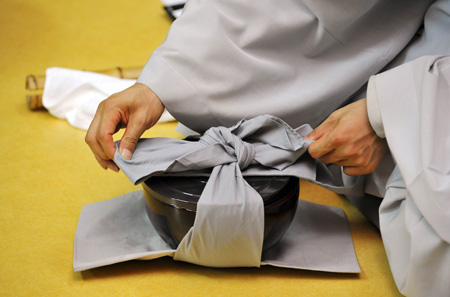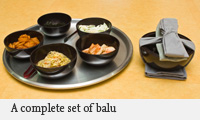
Buddhists have always regarded eating as a highly important religious act, nourishing the body properly so that development of the mind might continue to progress smoothly. What one eats and how one eats it are very significant, and ought to be approached with a conscious seriousness and sincerity. Further, our daily meals are recurring opportunities for expanding and deepening our awareness, as a type of meditation in themselves.
“Balu-gongyang’’ is our name for the traditional and formal communal meal practice unique to Korean Buddhist temples, using four bowls of different sizes and not wasting even a speck of food. Monks themselves do not eat this way at every meal, as some are taken more informally, but generally practice it in ceremonial situations and during seasonal intensive meditation sessions. This way-of-eating has, over the many centuries, become an integral feature of the Seon practices of the Jogye Order, and these days it is an important component of the templestay programs operated at many of the great monasteries across this nation.
The first time that I experienced a balu-gongyang ritual-meal in a Korean temple was a spiritual revelation. It was many years ago, at the great Mt. Hwangak Jikji monastery, and I had never before experienced such a religious way of eating. Ever since then I’ve had a much deeper appreciation for the spiritual factors inherently in accepting energy in the form of food into myself, with a sense of gratitude, austerity and togetherness with all beings. Its key values of consumption as a spiritual practice; thriftiness out of respect for the gifts we receive from nature, and practicing in silence so as to promote self-reflection, which have meant a lot to me.
Balu literally means “the four bowls containing food.’’ This tradition comes from a myth stating that after Sakyamuni attained enlightenment, the Four Heavenly Guardian Kings offered meals to him in stone bowls. A Korean Buddhist balu is a complete dining kit consisting of four matching bowls with a spoon, a pair of chopsticks, a place mat, a dish cloth, and a wrapping cloth to cover all. The bowls and utensils are usually made out of a polished hardwood with lovely natural grain patterns in it, but could also be metal or ceramic. The four bowls are of different sizes and can nestle into one another, with the entire set having a cover. From largest to smallest, they are bowls for rice, soup, side dishes and water.
Gong-yang means the serving of food to monastics, but can be also used when presenting them with clothing or other materials useful for their monastic life, including scriptures. The offering of food to Buddhist practitioners and their acceptance of it is just as serious and significant as offering them anything else, or making ceremonial offerings to the Buddhas and Bodhisattvas in the temple halls. Therefore the participants of this gongyang sit in the lotus position and do not speak any words or make any noises that are not necessary.
Only vegetarian foods are served within Buddhist temples, natural and nutritious, although monks and laypeople are free to eat other kinds of foods as needed or desired outside of the temple grounds. Participants should only take into their bowls as much of each food as they can eat within the time allowed, with concern that everyone present is offered an equal share. When they finish, not even a grain of rice or scrap of kimchi should remain in their bowls. It is really important to accurately judge how much you can and want to eat _ this is not a wedding buffet! Out of respect and gratitude for the food that comes to us from the earth’s biosphere through the hard labor of farmers, the generosity of donors and the diligent skill of the cooks and other staff, nothing at all should be wasted or discarded. This is a profound attitude of austerity, frugality, appreciation and environmental concern that is prominent throughout the Buddhist philosophies.

These monastic meals begin as the diners quietly gather in the hall, taking their balu kits from the cupboard and sitting on cushions in one or more rows. There is then a pre-meal sacred chant, emphasizing consciousness of harmoniously living together. Participants bow while seated, reflecting upon where this meal came from, the efforts that went into its production, whether our own virtue has recently been worthy of this offering, and how the energy we gain from this nutrition may be used in the improvement of our minds, the reduction of our craving and pride, and our hoped-for advancement upon the pathway towards enlightenment.
The officiating monk clacks his “jukbi’’ bamboo instrument at various times to prompt the diners to begin each stage of the complex balu-gongyang process. Water and foods are served and consumed in an orderly sequence. When finished, diners are served tea in their empty rice-bowls, used to clean out each bowl in turn using one piece of kimchi saved for rinsing. When all bowls are spotless, they drink the tea and eat the kimchi. The water received at the beginning and kept in the smallest bowl is used to give a final rinse to the three food-bowls, and then a bucket is passed around into which the diners all pour most of the water in their cleaning-bowls. The water in the bucket is to be inspected. If even a tiny bit of food remains in the tiny amount of water on the bottom of that smallest bowl, the diner has to drink it. The strict discipline of this practice clearly renvironmentalist Jane Goodall visited Korea in 2006, and spoke about her “Roots & Shoots Hopeful Table Campaign” that emphasizes education of children on the importance of eating organic foods in long-term sustainable amounts, environmental conservation and ecology-conscious lifestyles. She participated in a balu-gongyang of Korean Buddhist temple cuisine after her main speech, and declared afterwards that it was a very moving experience. She said that she had never eaten a meal in such a profoundly ceremonial fashion before, and that while chewing the food slowly and thinking about where it had come from she truly felt its value. She left with a very high impression of traditional Korean Buddhist monastic culture.
International visitors to our nation’s traditional monasteries may come to agree with her opinion, as I myself did long ago. Everyone can recognize that the balu gongyang practices are a unique Korean intangible cultural heritage treasure, raising our consciousness of what and how we eat. They serve as a good example for all humankind of how to nourish ourselves in harmony with nature and each other, frugally avoiding all needless waste while practicing the mindfulness we sorely need.
This reflects the deep Buddhist ecological and austerity values. The cleaned bowls and utensils are dried, bound and returned to the cupboards.
Source: The Korea Times




